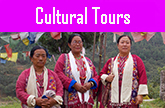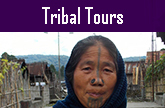Nagaland Tribal Tour
Tour Duration : 10 Nights / 11 Days
Travel Season : September to May
nagaland tribal tour itinerary:
Day 01: Arrive Dimapur
Meet upon arrival at Dimapur Airport / Railway Station and drive to the town.
Dimapur:
Dimapur, the gateway of Nagaland is designated to be the largest city in Nagaland, popularly known as the "City of River People". 'Dimapur' is a derivation from Kachari dialect in which 'di' implies river, 'ma' meaning great and 'pur' means city, together meaning "the city near the great river". This city, situated at an altitude of 475 feet above mean sea level is the most developed and industrialized area of the state.
Visit at Dimapur -
Medieval Ruins of Kachari Kingdom:
Dimapur holds the status of being the ancient capital of Kachari tribe who ruled the state before 13th century. The glory of the Kachari kingdom appears on the ruins spread around Dimapur. The ruins provide evidences of the Kachari civilization reflecting a touch of Hinduism who were pre-dominantly non-Aryans.
Diezephe Craft Village:
The village exhibits trained weavers and craftsmen skilled in wood carvings, bamboo and cane works. In recent times, the village has developed in this field of art expanding the variety of handloom and cane products with the assistance of Nagaland Handloom and Handicrafts Development Limited.
North East Zone Cultural Centre Museum:
This cultural centre set in a well conditioned museum organizes various cultural programs in and outside the state. Centre aims at the cultural promotion of the state and provides ample scope for tourists desiring to gain knowledge and information about the various cultural heritages of North Eastern people.
Later, check-in hotel.
Evening: Free at relaxation. Overnight: Stay in hotel.
Day 02: Dimapur - Kohima (74 kms, 3 hrs drive)
In the morning after breakfast, drive to Kohima -
Kohima:
The capital city of Nagaland, situated at an altitude of 4738 feet above mean sea level is encompassed by hills providing a majestic beauty to the city. The name 'Kohima' has been derived from Tenyidie dialect 'Kewheimia' meaning "people living in the hills". Kohima received its present name from the British rulers who had set up colonial units devastated during the Second World War. Kohima city is inhabited by the Angami, Rengma, Kuki and Zeliang Naga tribes. It is a beautiful hill station of North-East India beckoning the tourists to its religious, monumental and village attractions.
Arrive in Kohima and check-in hotel. Later visit -
Kisama Village:
Kohima village:
Kohima village, also known as Bara Basti is considered as the second largest village in Asia. It is also one of the most densely populated villages in the continent. Legend narrates that the village was set up by a man called Whinuo Kewhira. Kohima village is grouped into 4 khels namely Dapfutsuma, Lhisema, Pfuchatsuma and Tsutsonuoma. Several clans are brought together within the village community by the institution called 'khel' which governs the entire village. The membership of a khel depends on two aspects - birth or heredity. The ancient Kohima village was believed to possess 7 lakes along with 7 gateways. The main entrance of the village is set with a traditional wooden gate carved in traditional Naga art and decorated with horns of gayal (mithun) reflecting the glory of the ancestors of the village.
Catholic Cathedral:
The Catholic Cathedral standing on the Aradurah Hill is acclaimed as the largest cathedral in entire Asia. The birth of this cathedral took place after the battle of Kohima in the Second World War. It was established with an aim to offer prayers in loving memory of the sacrificed soldiers by Japanese survivors of the war. The cathedral covers a huge area of 25,000 sq feet showcasing a mixture of both modern and native architectural treat.
Kohima War Cemetary:
It is a war memorial set in the honour of those valorous soldiers and officers who sacrificed themselves during the Second World War. The cemetery, earlier known as 'Garrison Hill' is maintained by the Commonwealth War Graves Commission. Sir Edwin Lutyens was the principal architect of this cemetery. There stand 1421 magnificent stone graves of the brave soldiers killed in the battle of Kohima in April, 1944. Of these, 1070 graves are of soldiers from United Kingdom, 5 Canadian soldiers, 3 Australian soldiers, 33 graves of undivided India, 2 graves of East African soldiers, 1 from West Africa, 9 Burmese soldiers and a single non-war grave. Each grave bears an appropriate epitaph engraved in bronze. Historians regard the Battle of Kohima as "one of the bitterly fought battles of the Second World War". The British before departing Kohima had erected a heart touching inscription inside the memorial in the memory of brave comrades which reads: "When you go home, tell them of us and say: FOR YOUR TOMORROW, WE GAVE OUR TODAY."
Sales Emporium:
The Sales Emporium houses a wide collection of Naga handloom and handicraft items. Such handloom articles are also available in private outlets such as Gurtal (near war cemetery) and Belho Weavers (beside Assam Oil Company).
Evening: Free at relaxation. Overnight: Stay in hotel.
Day 03: Kohima
In the morning after breakfast, drive to Khonoma Green village.
Khonoma Green Village:
Khonoma village is the homeland of the Angami tribe. This 700 year old village also referred to as 'Khwunoria' by the inhabitants holds a historical record of a brave resistance made by the Naga warriors against the British in 1879 AD. The presence of a fort called 'Kuda', meaning "a place of defense" is a unique feature of this village. The villagers practice terrace farming of Alder trees which exhibits their skill in management of terraced cultivation. This farming fixes nitrogen in the soil which controls soil erosion. This step towards 'eco-tourism' has heightened the mission of "Green Khonoma" in the village.
In the late afternoon, take return transfer to Kohima.
Overnight: Stay in hotel.
Day 04: Kohima - Mokokchung (150 kms, 3 hrs drive)
In the morning after breakfast, take transfer to Mokokchung. En-route visit -
Tuophema Tourist Village:
An Angami Naga village, Tuophema tourist village was set in 1431, initially named after the 'Erithrina' tree. There was a belief among the villagers regarding the holy presence of the tree which they believed would make them victorious. Renowned as an eco tourist village, it is regarded as a model village under the Village Development Board covered by lovely cottages due to the proper execution of the village development programmes. Besides, The Nagaland Tourism Department has selected this village for the celebration of the Angami - Naga Sekrenyi festival celebrated during 25th - 27th February every year.
Tseminyu village:
Rengma tribe
Longsa Village:
Lotha tribe
Wokha:
The term ‘Wokha’ literally means census. Wokha is the homeland of the Lotha tribe as well as the district headquarters of Lothas, set amidst terraced fields, blooming bright flowers and picturesque surroundings. This village is highly acclaimed for its fertilizer and pesticide free cultivation of oranges and pineapples. The main attractions are the presence of ancient stone monoliths, constructed by tribal elders. Lothas are known for their colourful dances and songs.
Longkhum village:
Shrouded in full-bloomed Rhododendrons around the hillocks, Longkhum village is famous for exquisite ethnic handlooms and handicrafts. The village dwellers follow an animist religion called ................. and worship a God called Longlanpa Tsungrem.
Later, drive further to Mokokchung.
Mokokchung:
Arrive at Mokokchung and check-in hotel.
Overnight: Stay in hotel.
Day 05: Mokokchung
In the morning after breakfast, take an excursion tour of Mokokchung visiting -
Mopungchuket village:
Mopungchuket village is the homeland of the Aao Nagas. Beautiful traditional communal Naga houses named as Morung are found here. The inhabitants of the village are visitor-friendly and hospitable. This tribe celebrates numerous harvest festivals each year.
Ungma Village:
History narrates that Ungma village was founded by the Ao Naga tribe when they entered the terrain for the first time from their ancestral home at Chungliyimti. Ungma village is the desired destination of tourists interested in unique folklore, customs and traditions. It is the oldest and largest of all the Ao Naga villages and the second largest village in Nagaland next to Bara Basti or Kohima village. The homeland of the Ao Nagas, Ungma village has nurtured the rich Ao culture and traditions which is still prevalent among the villagers.
Evening: Free at relaxation. Overnight: Stay in hotel.
Day 06: Mokokchung - Jorhat - Mon (260 kms, 8 hrs drive)
In the early morning after breakfast, take transfer to Mon via Jorhat. En-route visit -
Jorhat:
Jorhat is known as one of the leading towns of Assam and the centre of tea industry. The earlier Jorhat town was sought to ruins as a result of the Burmese invasions in 1817 AD. But as the British ventured into Assam in 1824 AD, these invasions were cleared out under the British administrative officers, David Scott and Captain Richard. Present day Jorhat is the hometown of the world famous Tocklai Tea Research Center, Assam Agricultural University, North-East Institute of Science & Technology and the head office of Assam Sahitya Sabha. There are about 140 tea gardens in and around Jorhat.
If time permits, visit –
Tocklai Tea Research Institute:
The Tocklai Tea Research Institute, previously known as Tocklai Experimental Station is the oldest and largest research institute of its kind in the world. It was established in 1911 AD. It carries out all research projects at national level on all aspects of tea cultivation and processing. It encompasses a large network covering South Bank, North Bank, Upper Assam, Cachar, Darjeeling and Terai. This research station has contributed largely in the increase of tea production which greatly adds to the economy of India. Recent data states that total clone species of tea derived in Tocklai Tea Research Institute numbers to 31. Till date, the institute has succeeded in inventing total number of 213 tea species. Through the effort of the Scientists involved in various tea research projects, 14 numbers of tea seeds have been invented in this institute.
Later, depart to Mon.
Mon:
Mon is the homeland of the former head hunters, the Konyak Nagas. They are well equipped with the skill of craftsmanship in wood carvings, guns, gunpowder, headgears and metal ornaments. The presence of semi traditional villages and tattooed warriors in loin cloths is the famous attraction of Mon.
Arrive at Mon and check-in guest house.
Evening: Free at leisure. Overnight: Stay in guest house.
Day 07: Mon
In the morning after breakfast, visit at Mon -
Mon village:
Shangnyu village:
Shangnyu village, considered as one of the prominent villages in Mon district is ruled by the Chief Angh. History speaks of amiable relationship between Shangnyu and Angh kings. The responsibility of collection of taxes rested on the Shangnyu Angh. Their collection areas used to comprise of villages starting from Sivasagar in Assam to the Wanchos in Arunachal Pradesh. The main attraction of this village is a huge and unique piece of wood carving of the metallic age measuring ……………… , placed in a concrete museum at the entrance of the Angh’s house. This wonderful wooden monument engraved in human and other creature’s carving is about 500 or 600 years old and is believed to be constructed by two brothers with the help of heavenly spirits.
Afternoon visit -
Chui village:
Overnight: Stay in guest house.
Day 08: Mon - Longwa - Mon (44 kms one way, 2 hrs drive)
In the morning after breakfast, take an excursion of Mon to visit -
Longwa village:
Return to Mon.
Overnight: Stay in guest house.
Day 09: Mon - Dibrugarh (210 kms, 5 hrs drive)
In the morning after breakfast, take transfer to Dibrugarh. En-route visit -
Sivasagar:
Literally, the name 'Sivasagar' means 'Ocean of Lord Shiva'. This historical city of Assam remained the capital seat of the mighty Ahoms who ruled over Assam for nearly 600 years till the arrival of the British. It reflects the glory of ancient Assam under the Ahom rule. The Ahom monarchs started the tradition of building royal palaces, tanks, roads, forts, temples, towns, embankments, bridges of stones and bricks all over the kingdom. Apart from representing a number of monuments of rare historical and archaeological significance, modern Sivasagar has grown as a fast developing town with leading oil and tea producing areas.
At Sivasagar, visit -
Shiva Dole:
This famous Shiva temple was built by the second queen of Shiva Singha, Queen Ambika in 1734 AD. It is reputed to be the tallest Shiva Temple in India with a height of 180 feet and 195 feet in diameter caped by seven feet height golden dome.
Sivasagar Tank (Barpukhuri):
The famous Sivasagar tank was dug in 1734 AD by Queen Ambika, the second queen of King Shiva Singha to honor the memory of her husband. The tank covers an area of 129 acres of land. The water level of the tank remains always above the level of the town and never changes. Due to its big size and depth, it is regarded as 'Sagar' meaning 'sea'.
Rang Ghar:
Rang Ghar is a historic amphitheatre constructed during the rule of Ahom king Pramatta Singha in 1746AD. During those times, Rang Ghar acted as a royal pavilion where the Ahom royalties and officers witnessed several outdoor games such as wrestling, buffalo-fight, falconry, elephant fights and other sporting and cultural events. It is an antique oval-shaped two storied building. The ground floor is rectangular in shape with two trapezoidal ends. Due to its typical and special structure, it has become a symbol of modern Assam.
Tolatol Ghar:
Tolatol Ghar was originally constructed by Ahom King Rudra Singha in 1699AD. Several changes and additions were made by the later Ahom rulers and this palace got its present structure of bricks and indigenous type of cement during 1751-1769AD under Ahom king Rajeshwar Singha. It is a seven storied palace of which four stories are above ground and the remaining three stories are underground with two underground tunnels, one leading to Dikhow River and the other to Gorgaon Palace at Nazira. It was also once the capital and military station of the Ahom kings.
Later, drive further to Dibrugarh.
Dibrugarh:
The 'Tea City of India', Dibrugarh is located in the eastern part of Assam. It is situated on the banks of the river Brahmaputra in upper Assam. Main attraction is mainly tea gardens along with oil and natural gas reserves. There are more than 165 tea gardens in and around Dibrugarh district. The foothills region of Dibrugarh is composed of lateritic soils, which is suitable for the production of tea plants. Besides, Dibrugarh city is the main educational centre of Upper Assam with important educational institutions like Dibrugarh University, Assam Medical College, Kanoi College, Salt Brook Academy etc.
Arrive at Dibrugarh town and check-in hotel.
Overnight: Stay in hotel.
Day 10: Dibrugarh - Namphake Village - Dibrugarh (40 kms one way)
In the morning after early breakfast, take transfer to Namphake Village.
Namphake Village:
The Phakial community of Assam established Namphake village in 1850 AD. Presently, the village is inhabited by 600 members of the community. The word ‘Phake’, connected with Tai community, is a combination of two Tai words ie, ‘Pha’ and ‘ke’ meaning ‘wall’ and ‘ancient’ respectively. Historically, natives in Myanmar dwelling near ancient stone walls were recognized as ‘kunphake’ meaning “people inhabiting near phake part of the country”. The present inhabitants of Namphake village are considered to be the descendants of those ‘phake’ people of Myanmar. The Tai race, a large section of nomadic Mongolian association, currently inhabits in entire Asia. In Myanmar, Thailand and Yunnan province of China, they are recognized as the Shan, Siamese and Pai respectively. In countries like Cambodia, Laos and Vietnam, they are familiar as the Lao population. Tai Phake people in Assam are popularly known as ‘Phakial’. Many noted historians of Assam opine that the Phakials are immediate descendants of the mighty Ahoms. Phakial people established some other villages like Borphake, Tipamphake in the districts located in upper Assam. Yet the largest village among all is the Namphake village near Naharkatiya. In spite of being fused into greater Assamese culture, the Phakial community has been conserving its own distinctive culture and age old traditions and thereby contributing to the rich Assamese culture. Followers of Buddhism, the Phakials in Namphake village are maintaining a Buddhist monastery with several astounding monuments within its premises. Moreover, a Buddhist Pagoda and a symbolic Ashoka pillar in the monastery premises are worth seeing.
Later, return to Dibrugarh. Visit a Sonowal Kachari Village like Hatimora, Bogpara, Chaulkhowa, Niz Mankotta, Tepor Gaon, Boiragimath.
Sonowal Kachari village:
Designated to be the scheduled Bodo tribal community, Sonowal Kacharis form the third largest tribal group (plains) of Assam. They are primarily found in the districts of Dibrugarh, Tinsukia, Jorhat, Golaghat, Sivasagar, Lakhimpur and Dhemaji. It has been very difficult to trace the origin of Sonowal Kacharis over the years. It is popularly believed that a few population of the Kachari tribal community were occupied in cleaning gold elements from the sands of river during the reign of the Ahom rulers. Thus, the prefix 'Sonowal' meaning ‘gold washer’ was added before their main tribal identity ‘kachari’ to indicate their particular population. A famous anecdote recommends that during the rule of Ahom king Godadhar Singha, a 'Gossian' (meaning a priest) named 'Kechaideo' had mystical powers of contributimg a definite quantity of gold in a bamboo tube. After becoming followers of 'Kechaideo', these people became popular as Sonowal Kacharis.
Sonowal Kacharis have 7 exogamous clans namely Chiripuria, Balikhitiari, Ujani-Kuchiya, Amarabamiya, Tipamiya, Dhulial and Namoni-Kuchiya. Yet again, these clans are sub grouped into 14 sub-clans namely Muktal, Hagral, Borttajoal, Madan, Ahmal, Manikiyal, Dhekial, Formal, Oingial, Saru Hazowal,Dangral, Kumral, Chetial and Lothial. Sonowal Kacharis are dedicated followers of Vaishnavism. Some prominent songs of Sonowal Kacharis are Husori, Haidang, Biya naam, Aai naam, Gossain Naam, Dhai naam, Apeswara Naam and Lakhimi naam. Some amazing traditional dance forms in addition to Bihu are Bohuwa dance, Kula-burhir dance and Hugra dance.
The Sonowal Kacharis presently do not have any particular dialect of their own. They commonly speak Assamese language. During Ahom rule, the Sonowal Kacharis in their course of integration with the non tribal communities adopted non tribal surnames like Bora, Saikia, Hazarika etc. Agriculture and poultry farming of rearing hens, ducks & cattle are the major occupations of Sonowal Kacharis. Drinking of Rice Beer is a popular habit among masses. Weaving at traditional ordinary weaving machines at home to produce items like endi chadar (silk cloth) and gamocha is a customary activity among women.
Overnight: Stay in hotel.
Day 11: Dibrugarh departure
In the morning after breakfast, take transfer to Dibrugarh Airport / Railway Station for your onward destination.
Tour terminates here
North East India Tourism
Package Inclusions:
# All ground transportation by a comfortable vehicle driven by dedicated driver
Package Exclusions:
# Any air fare or train fare


















